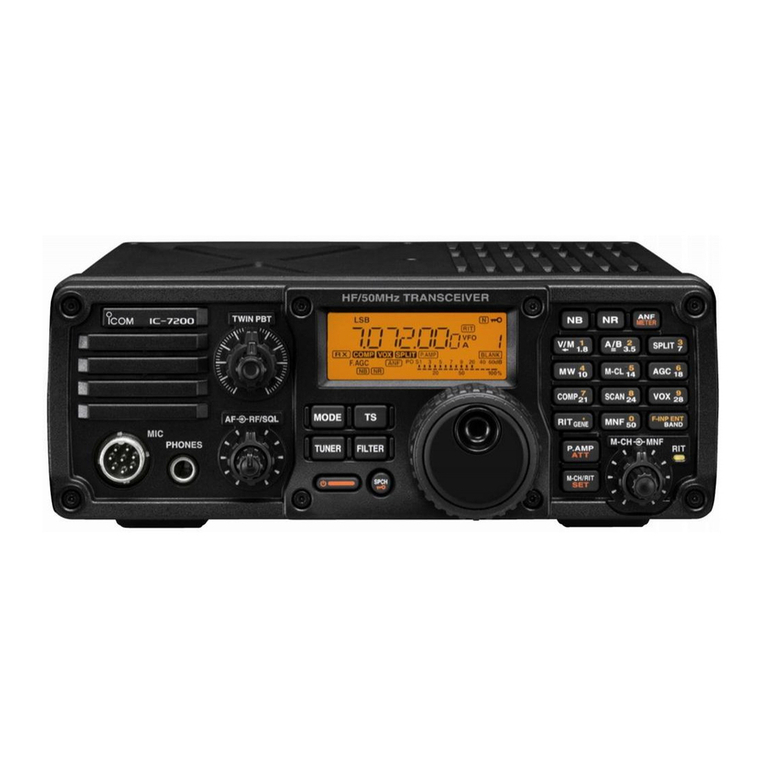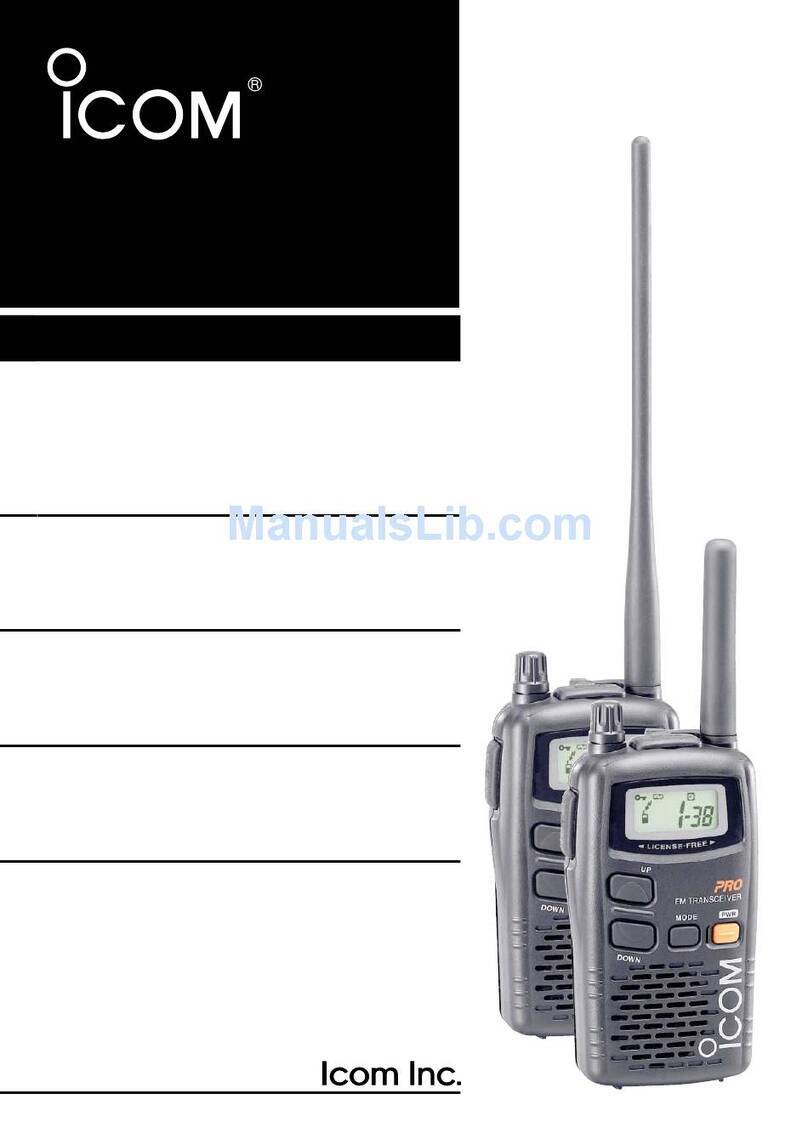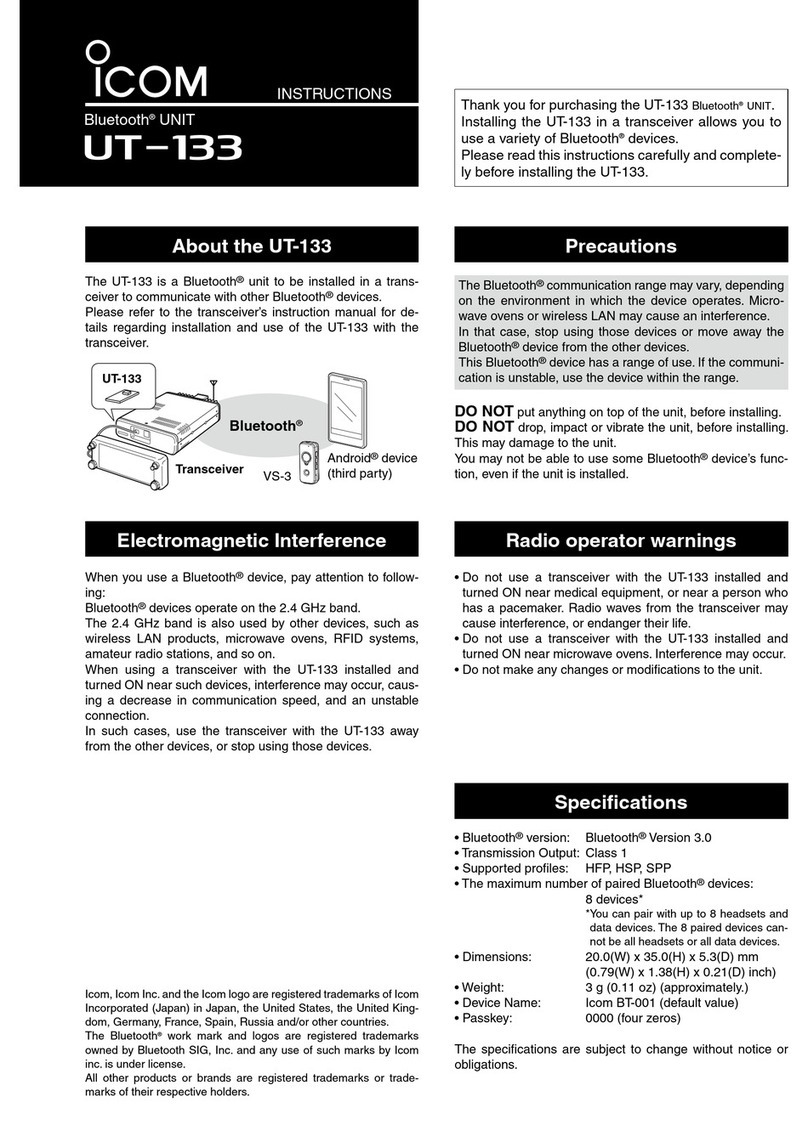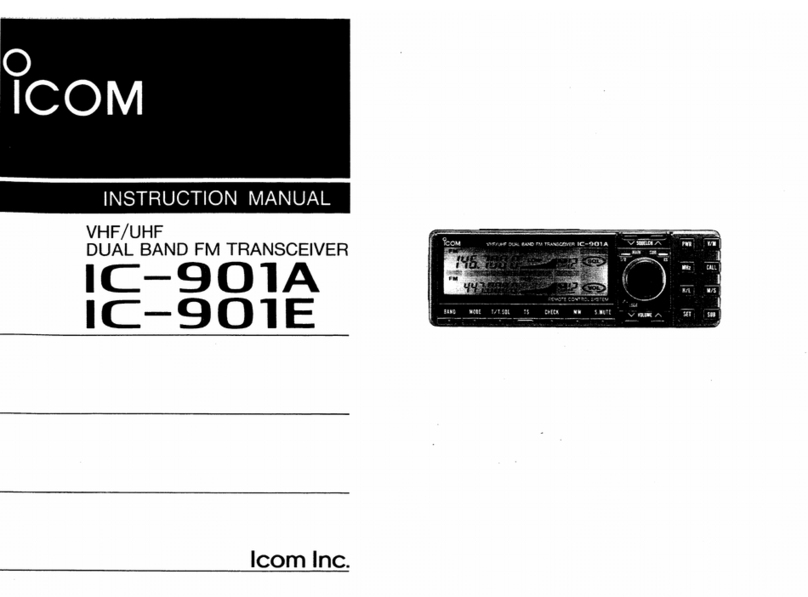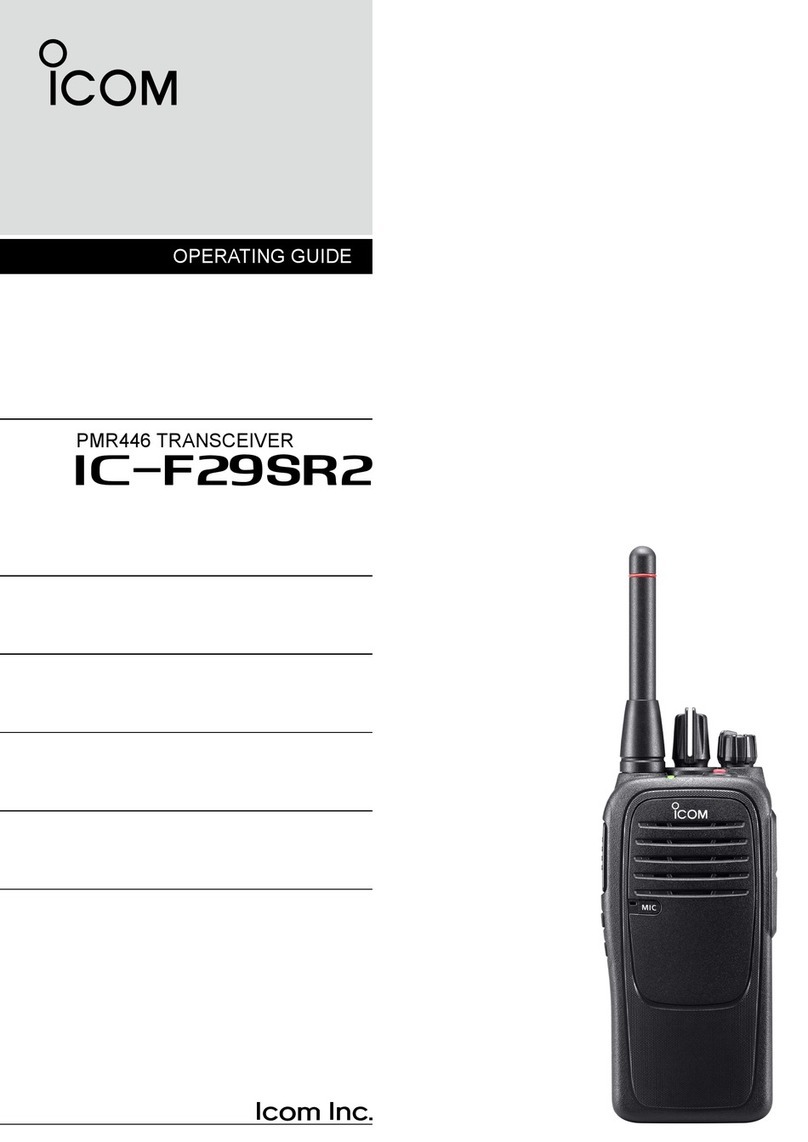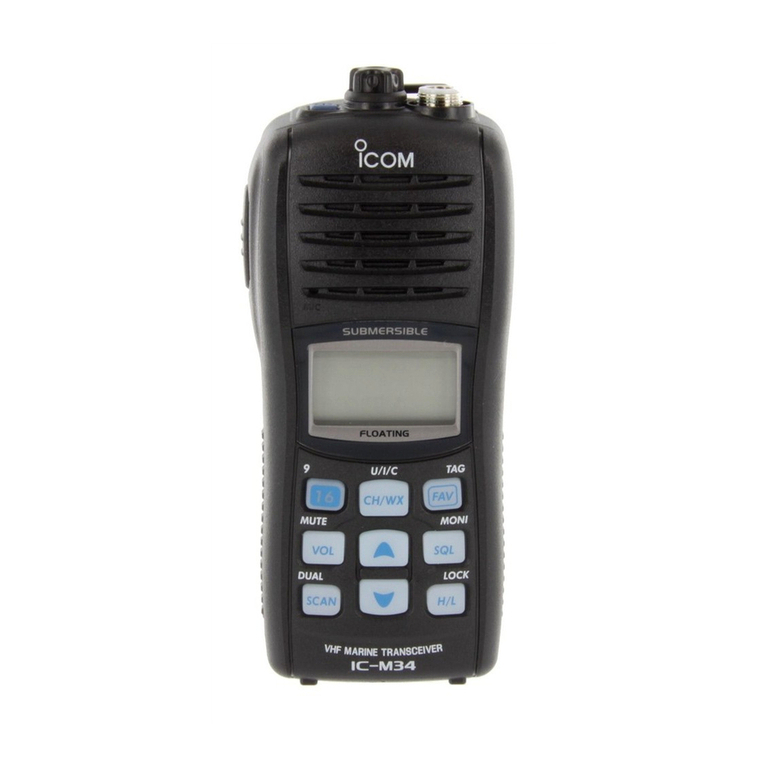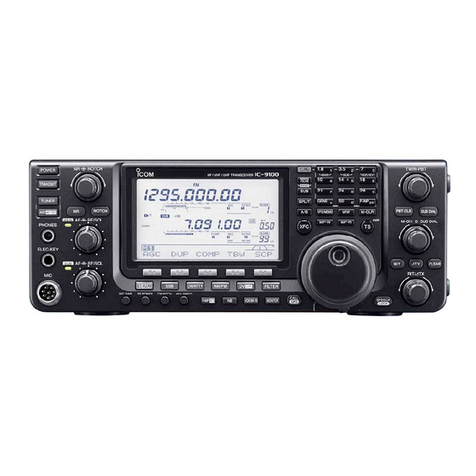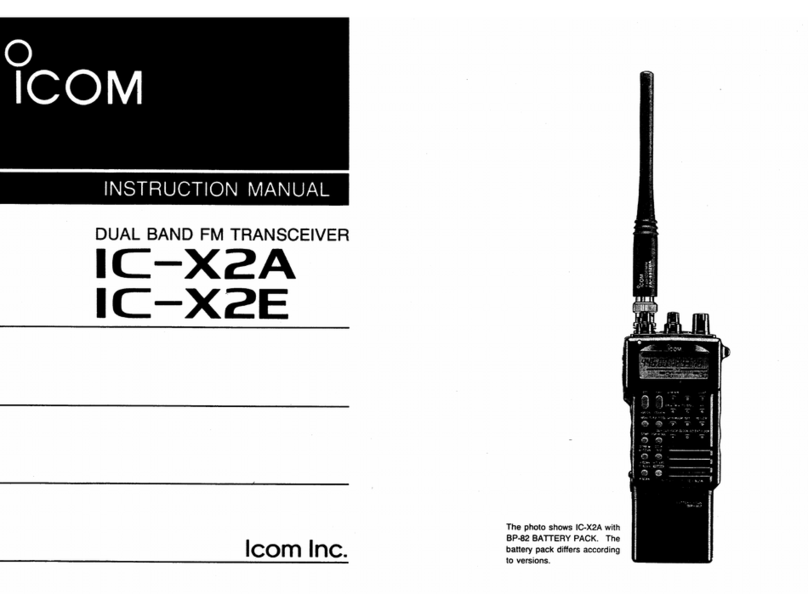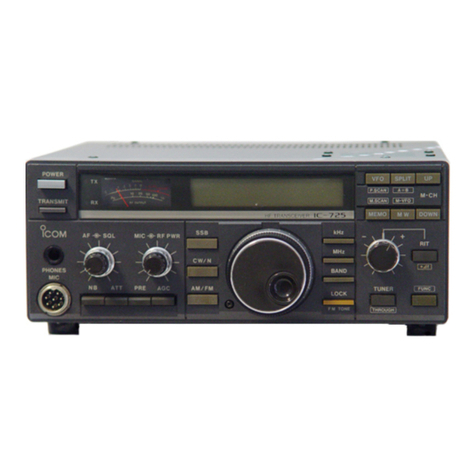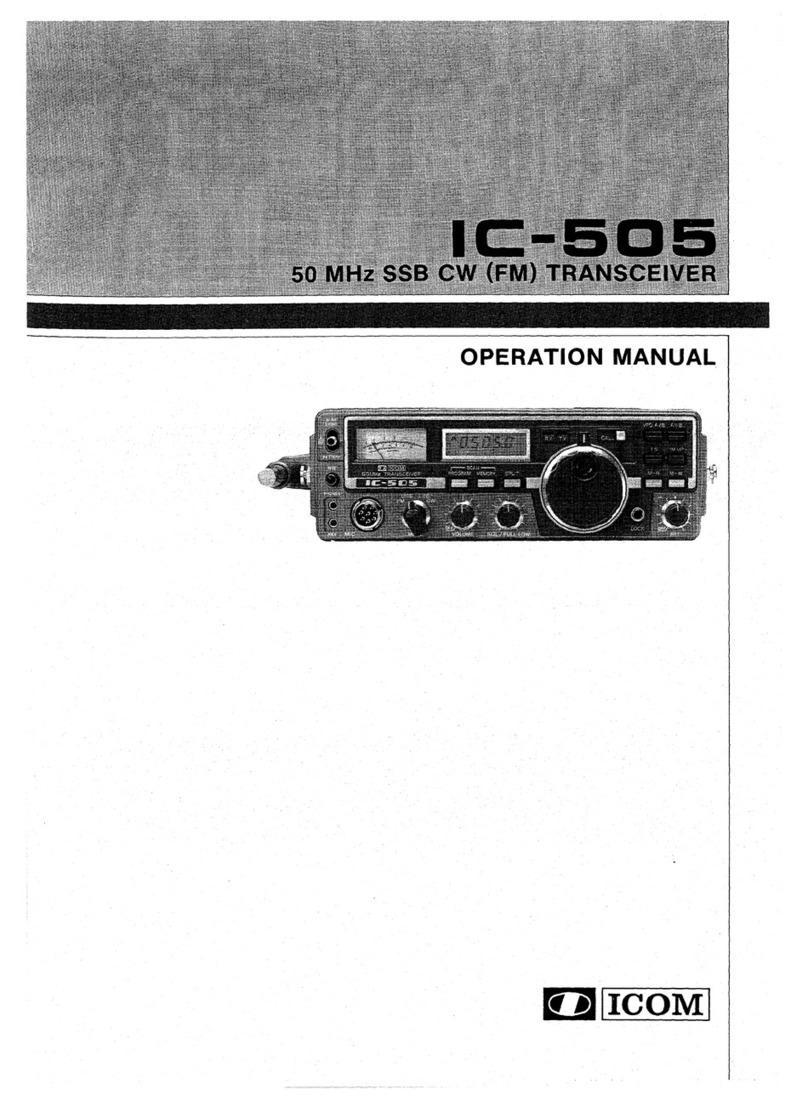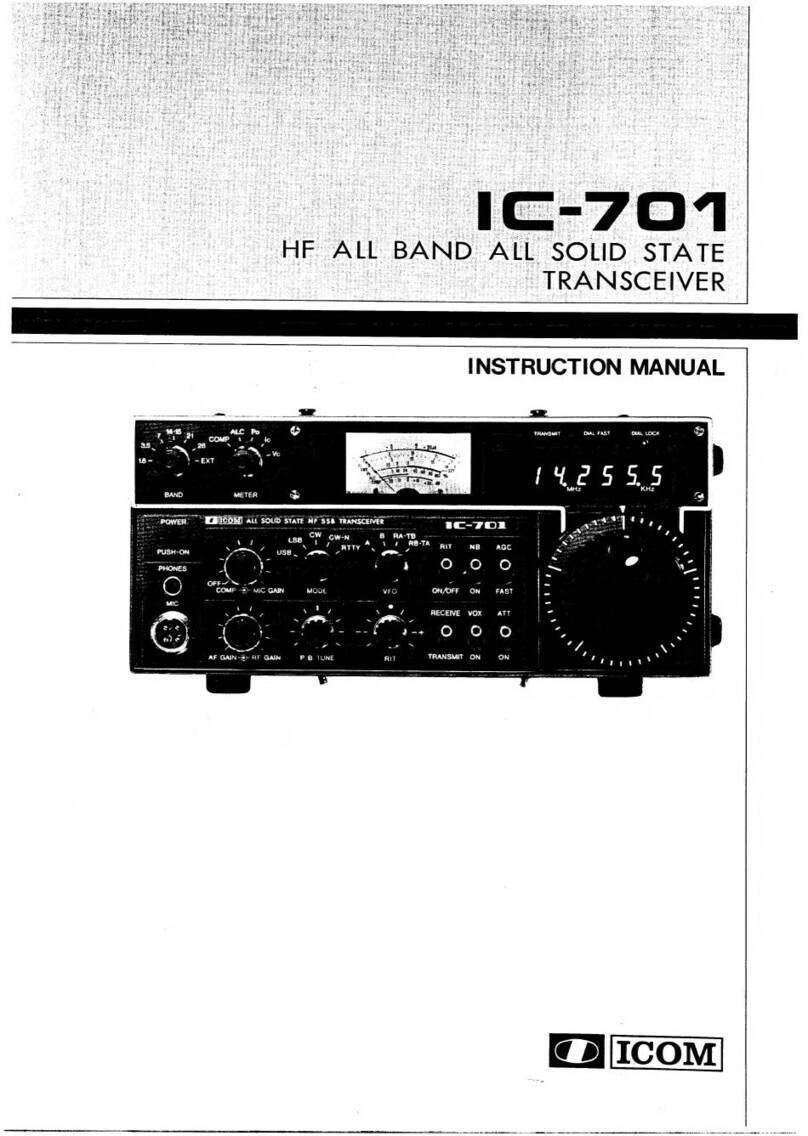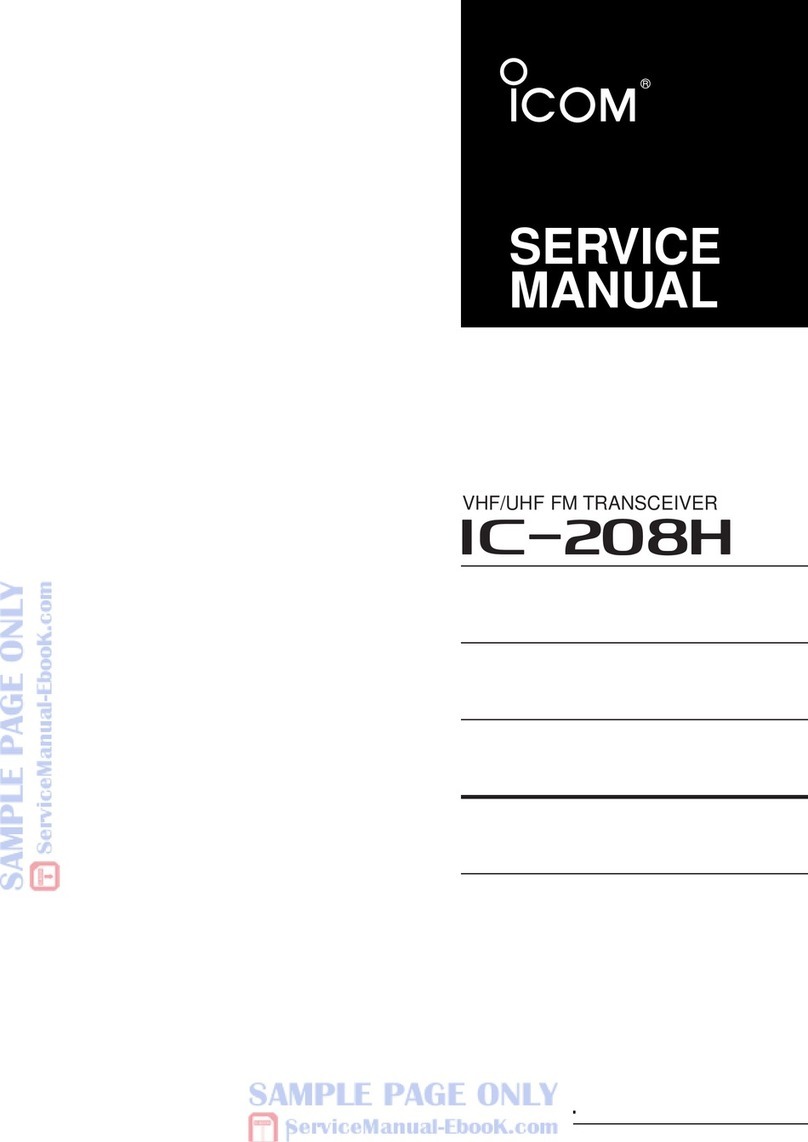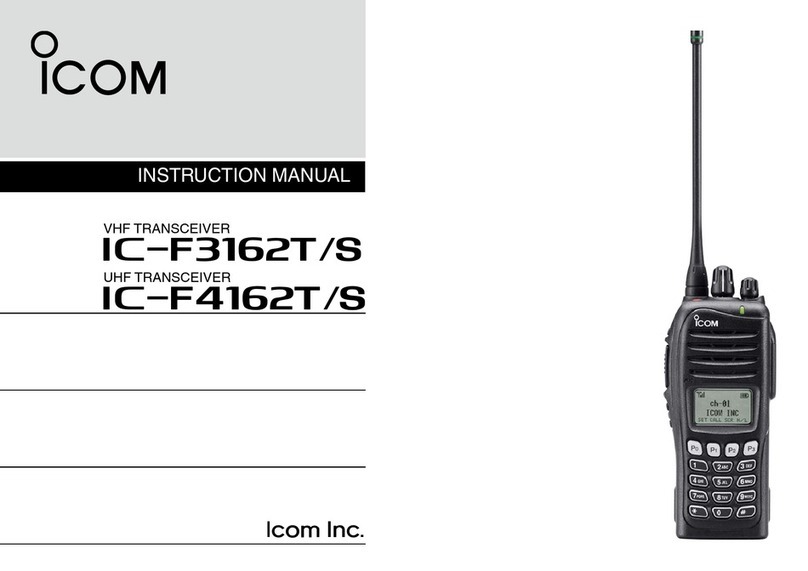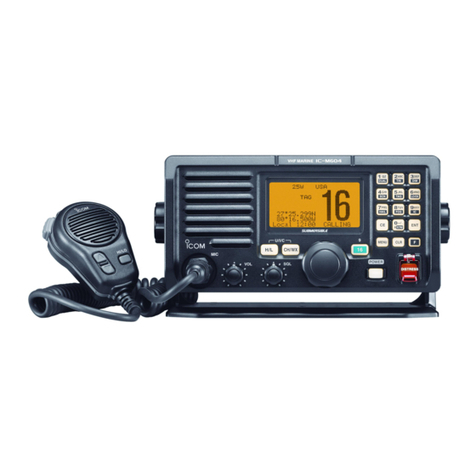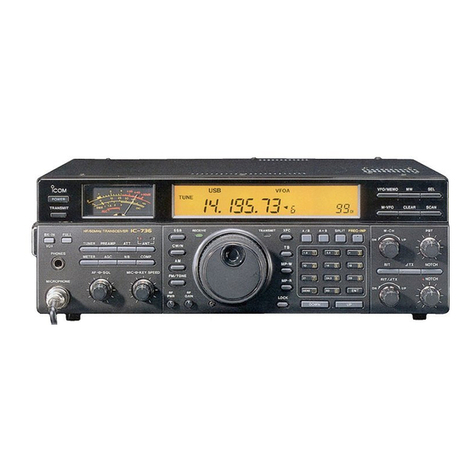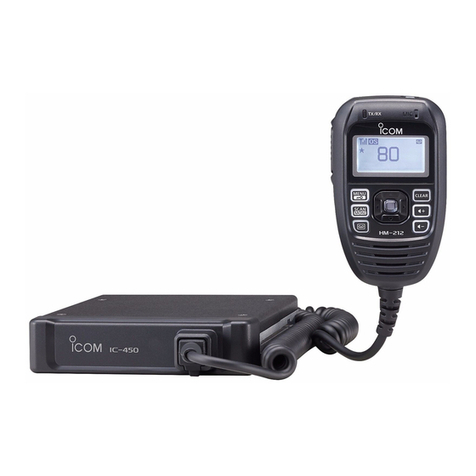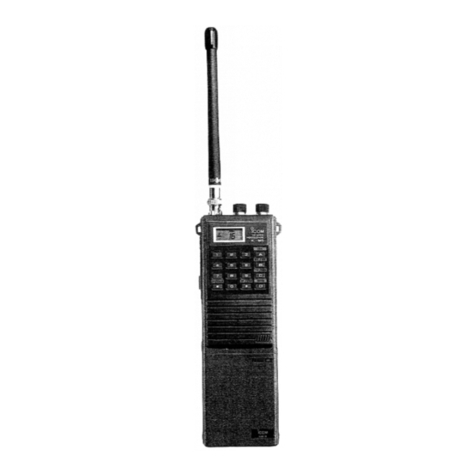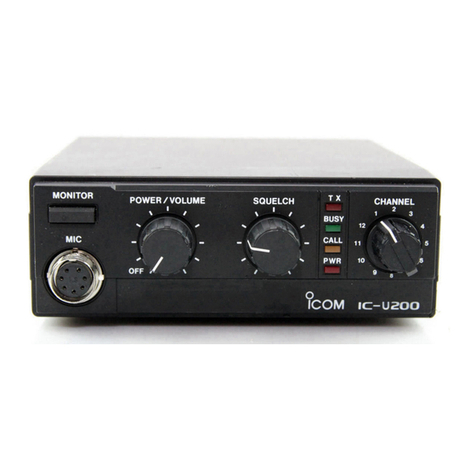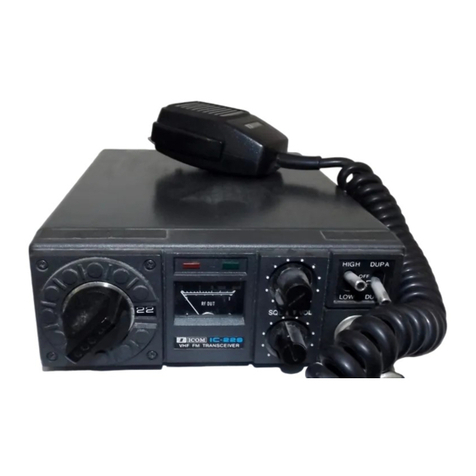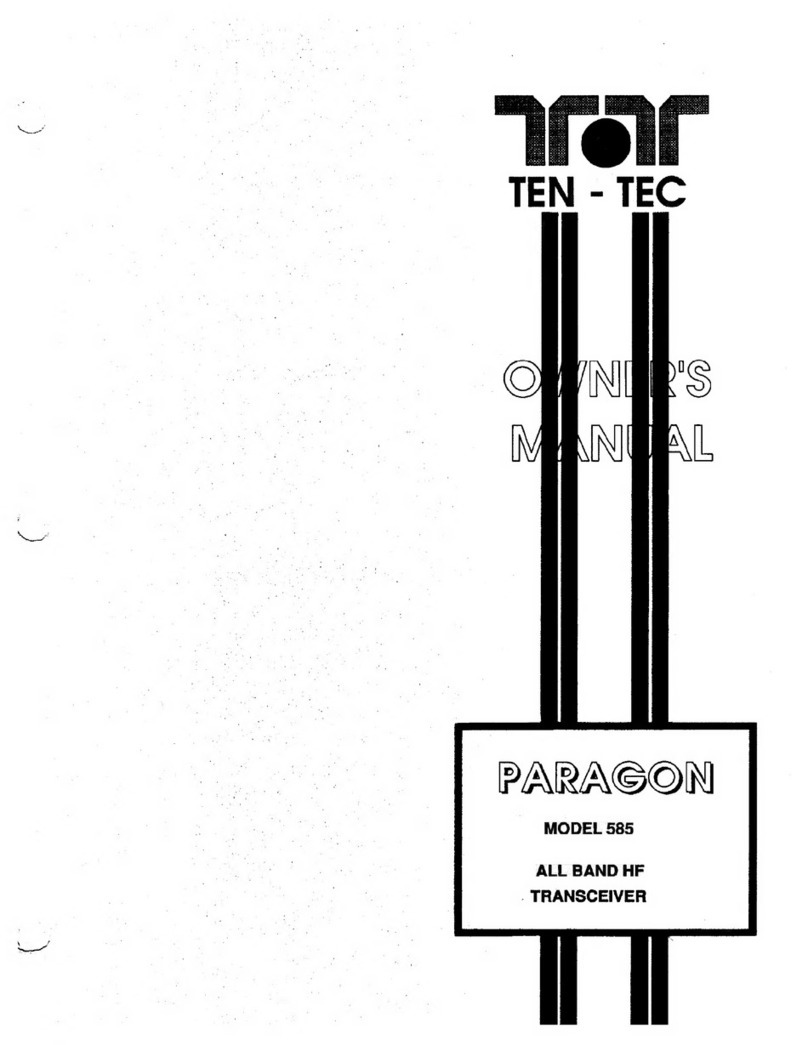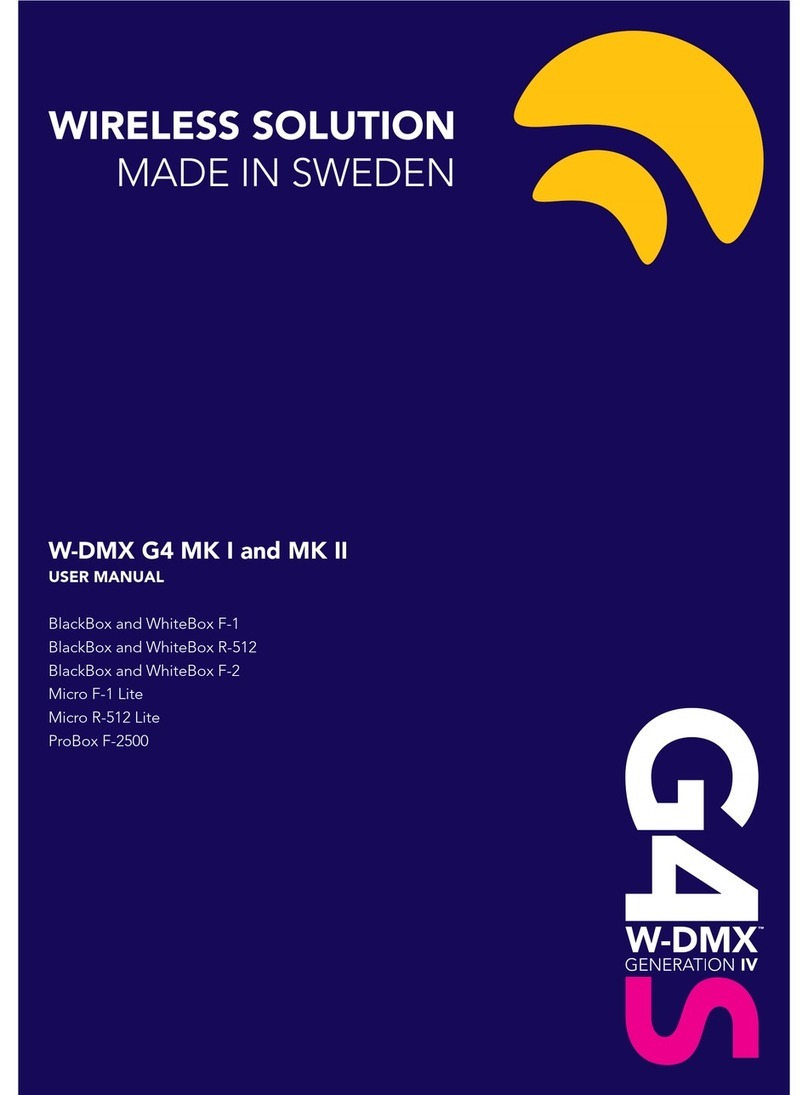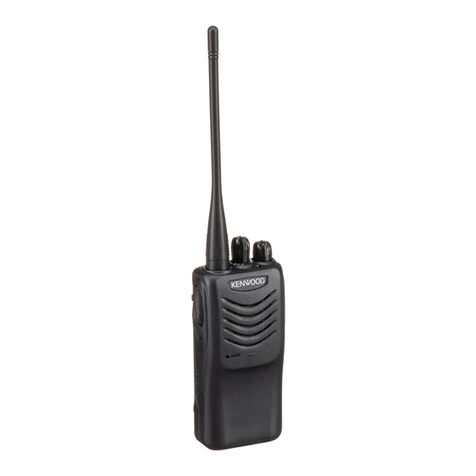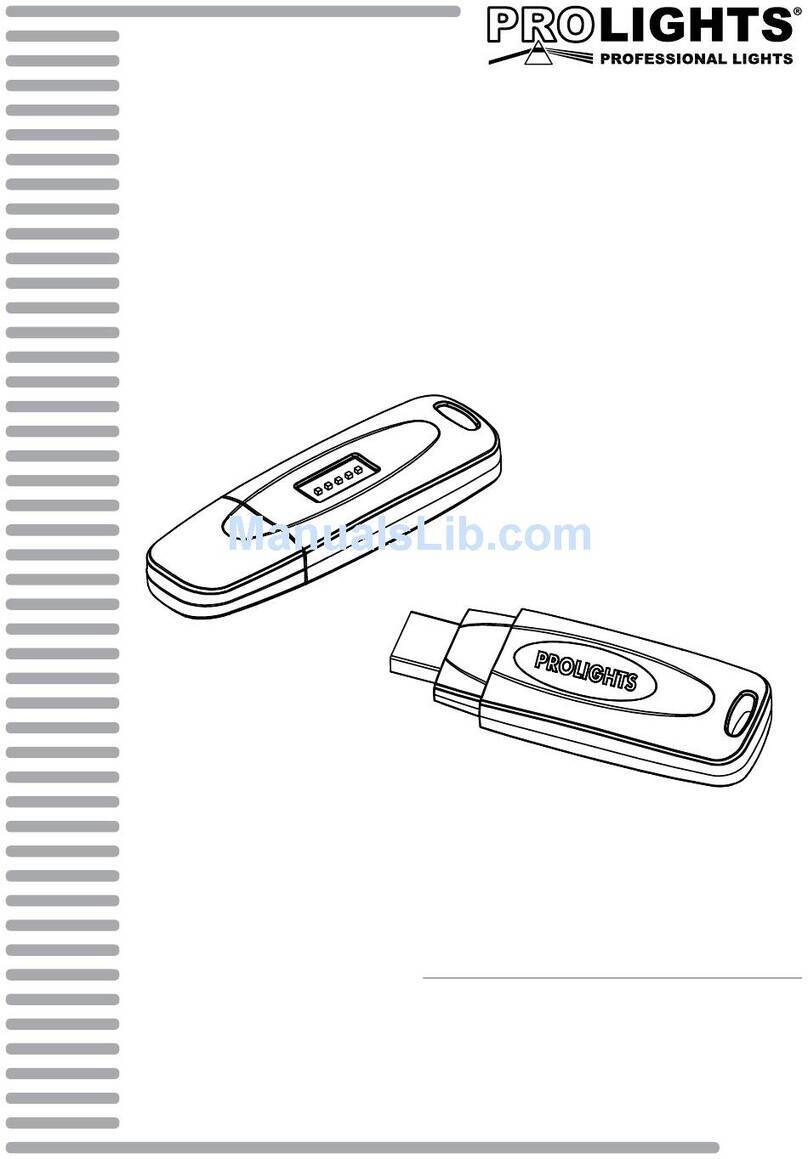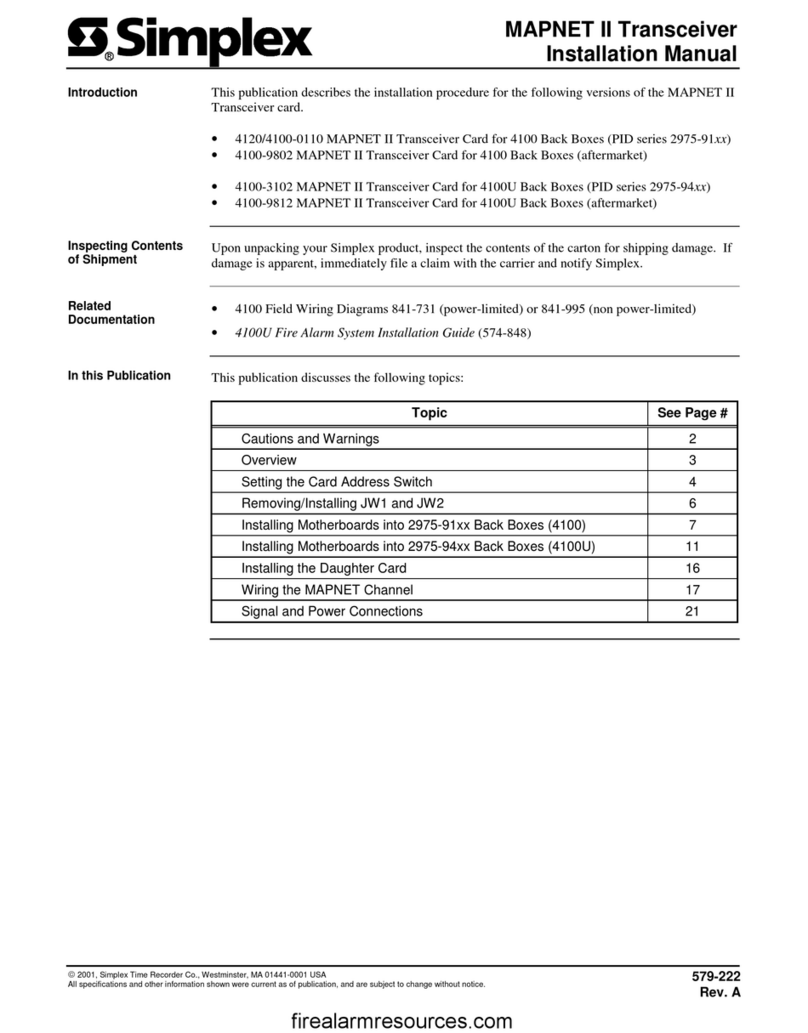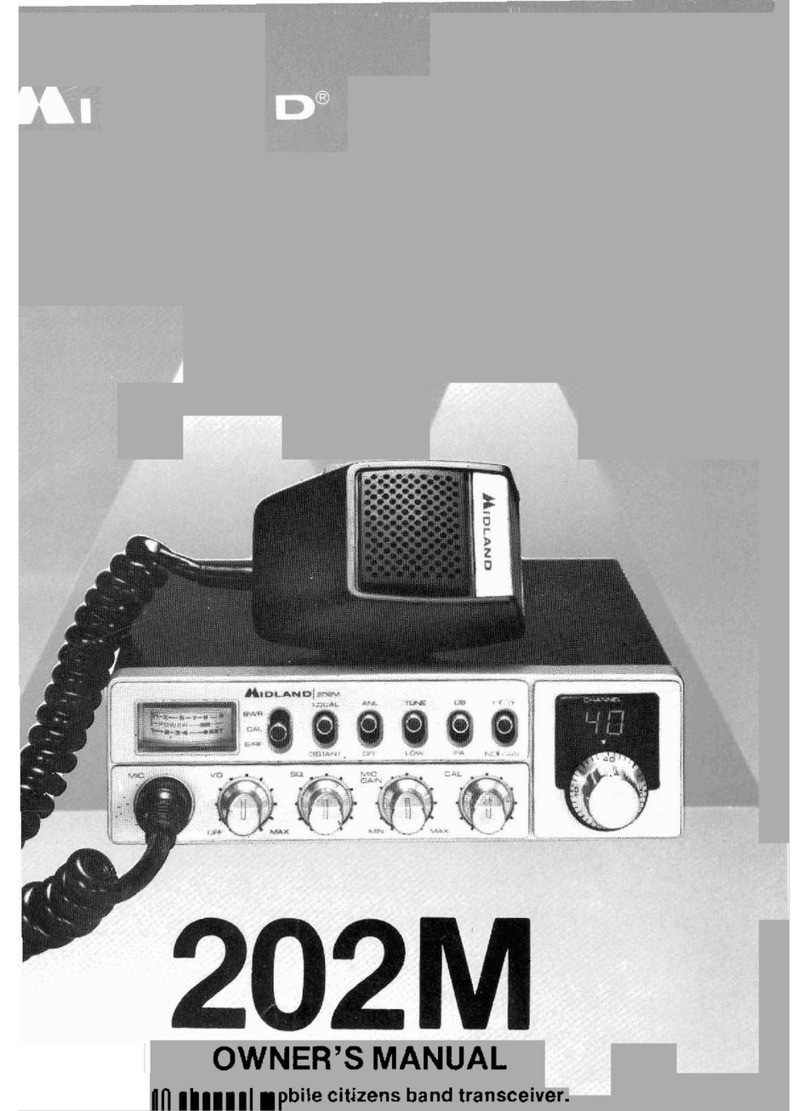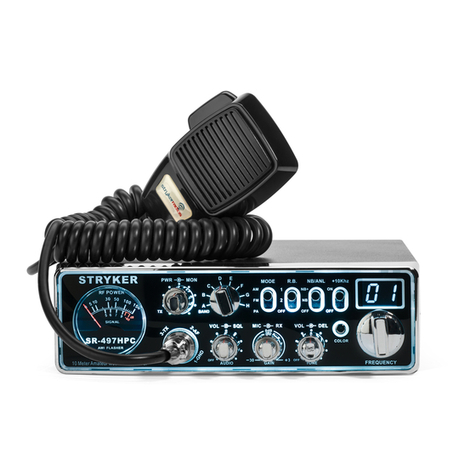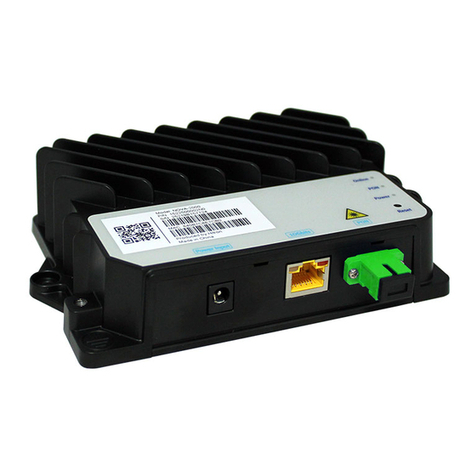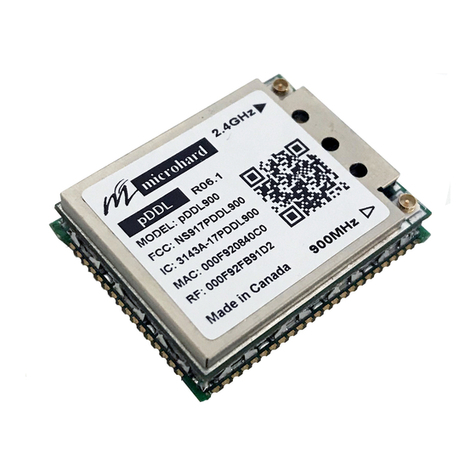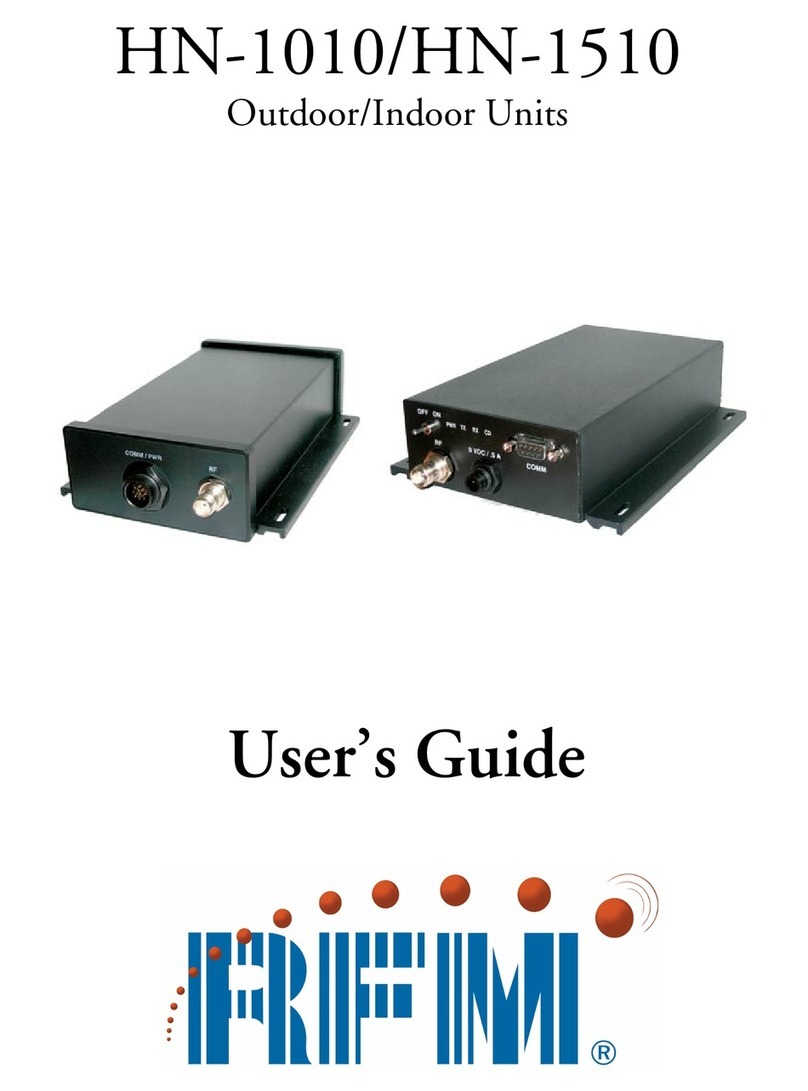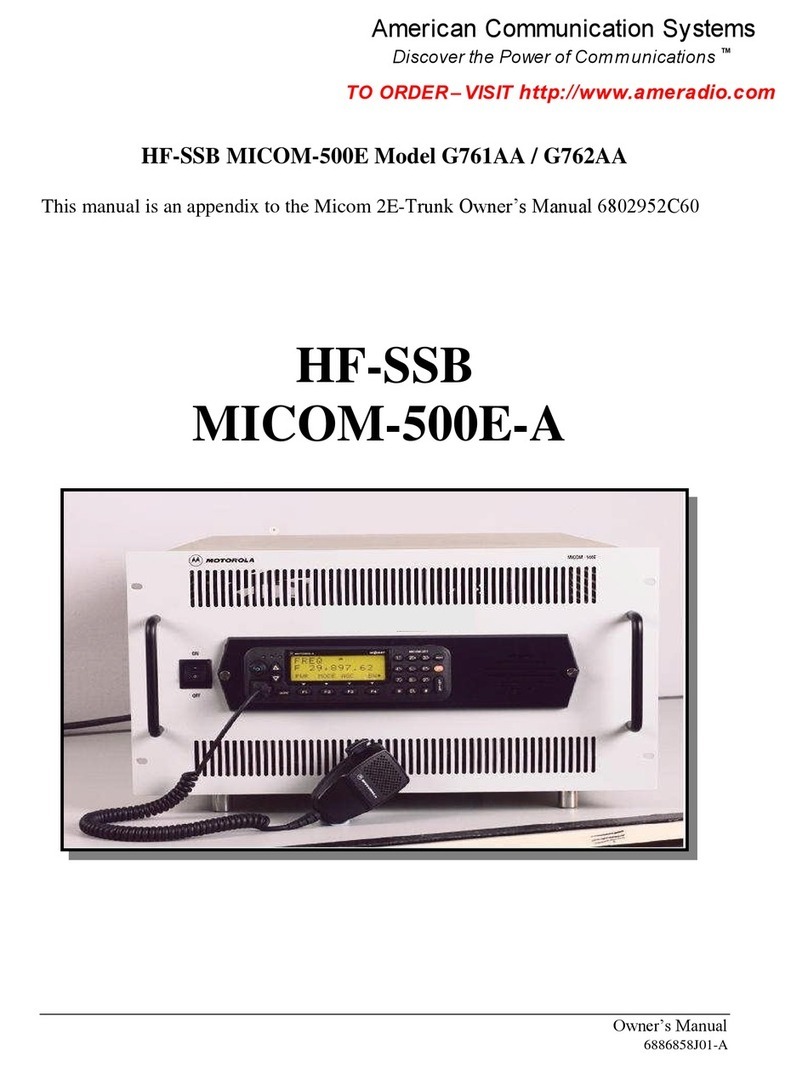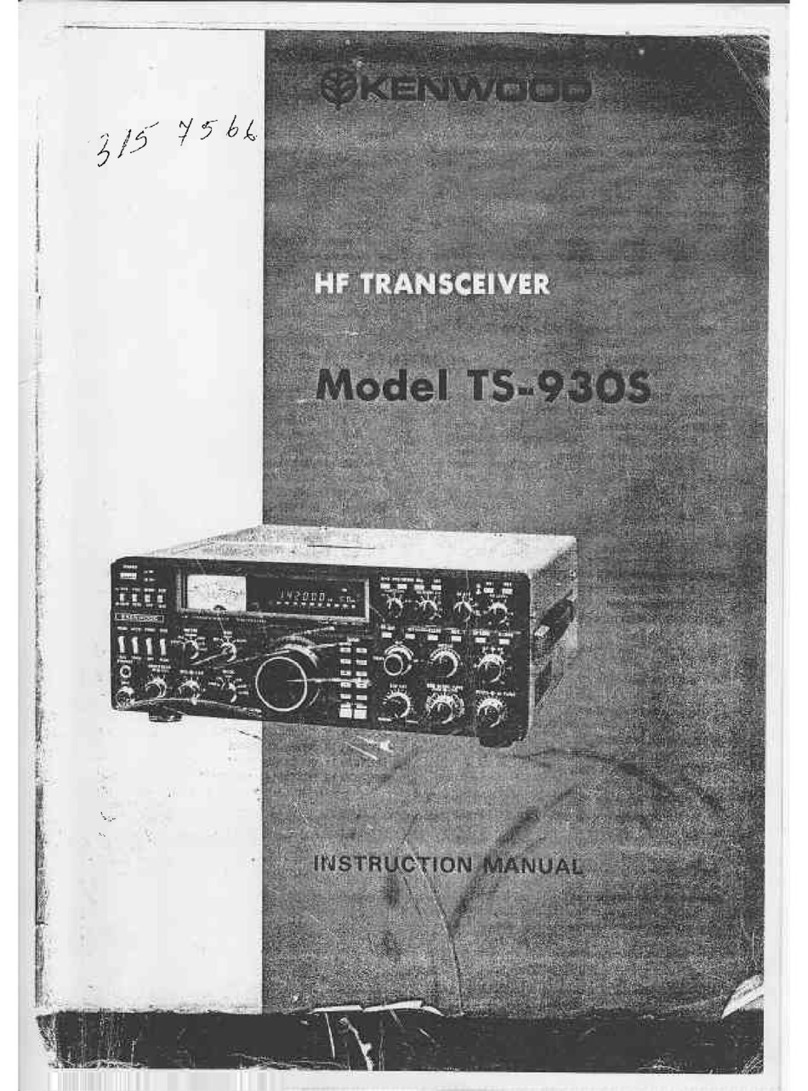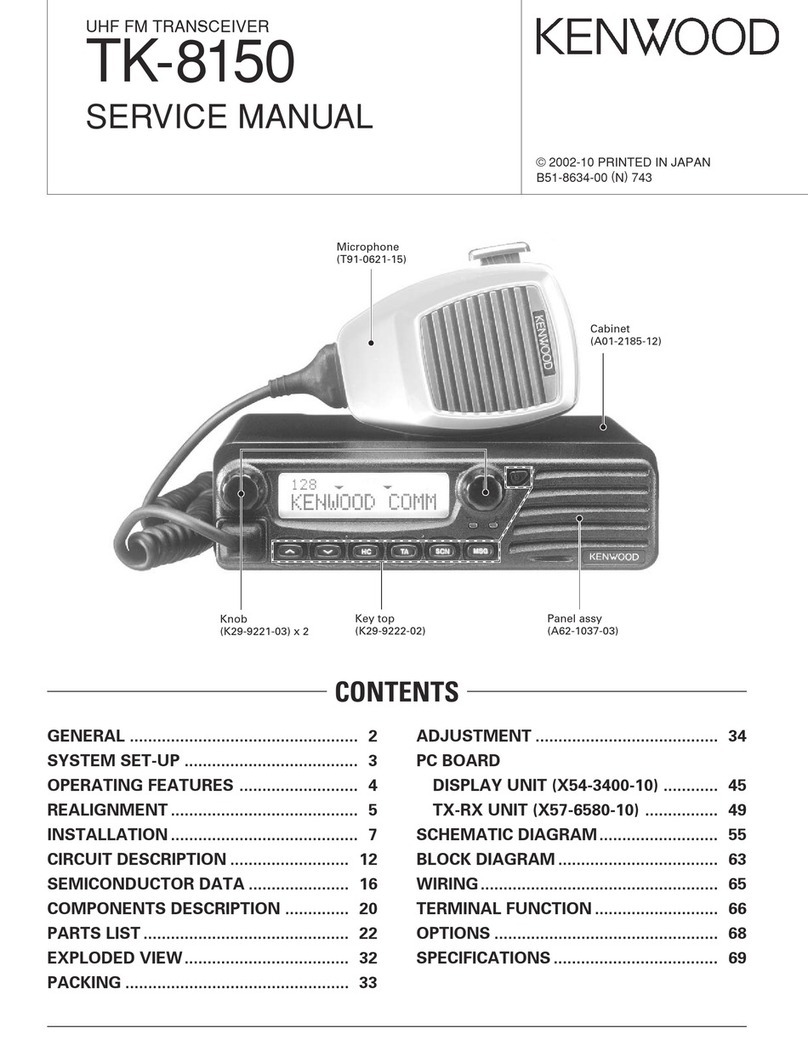Icom IC-M803 User manual

SERVICE
MANUAL
S-15612XZ-C1
March 2020
MF/HF MARINE TRANSCEIVER
|M803

INTRODUCTION
This service manual describes the latest technical
information for the IC-M803 MF/HF MARINE
TRANSCEIVER at the time of publication.
MODEL VERSION VERSION
NUMBER
IC-M803 USA #11
To upgrade quality, any electrical or mechanical parts and
internal circuits are subject to change without notice or
obligation.
SERVICE CAUTION
NEVER connect the transceiver to an AC outlet or
to a DC power supply that outputs more than the
specified voltage. This will ruin the transceiver.
DO NOT expose the transceiver’s main unit to rain,
snow or liquids.
DO NOT reverse the polarity of the DC power cable
when directly connecting to the transceiver.
DO NOT apply an RF signal of more than 20 dBm
(100 mW) to the antenna connector. This could
damage the transceiver’s front-end.
ORDERING PARTS
Be sure to include the following four points when
ordering replacement parts:
1. 10-digit Icom part number
2. Component name
3. Equipment model name and unit name
4. Quantity required
<ORDER EXAMPLE>
1130016460 R2A20169SA IC-M803 MAIN UNIT 5 pieces
8930102460 4100 IC CLIP IC-M803 CHASSIS 1 piece
Addresses are provided on the inside back cover for
your convenience.
REPAIR NOTES
1. Make sure that the problem is internal before
disassembling the transceiver.
2. DO NOT open the transceiver until it is
disconnected from its power source.
3. DO NOT short any circuits or electronic parts.
4. DO NOT keep power ON for a long time when the
transceiver is defective.
5. NEVER directly transmit power into any test
equipment such as Standard Signal Generator,
otherwise the RF power may damage them.
6. ALWAYS connect a 50 dB to 60 dB attenuator
between the transceiver and such test equipment.
7. READ the instructions of the test equipment
thoroughly before connecting it to the transceiver.
8. If the front panel and case of the remote controller
are separated and reassembled, waterproof
performance will not be guaranteed unless the
specified waterproof check is performed.
Icom, Icom Inc. and the Icom logo are registered trademarks of Icom Incorporated (Japan) in Japan, the United States, the
United Kingdom, Germany, France, Spain, Russia, Australia, New Zealand, and/or other countries.
REMOTE CONTROLLER
IC-M803 MAIN UNIT
IC-M803
MICROPHONE
HM-214

TABLE OF CONTENTS
SECTION 1 SPECIFICATIONS
SECTION 2 INSIDE VIEWS
SECTION 3 DISASSEMBLY INSTRUCTION
SECTION 4 INTERFACE INFORMATION
SECTION 5 ADJUSTMENT PROCEDURE
5-1 PREPARATION ……………………………………………………………………………………… 5-1
5-2 FREQUENCY ADJUSTMENT……………………………………………………………………… 5-3
5-3 RECEIVE ADJUSTMENTS ………………………………………………………………………… 5-3
5-4 TRANSMIT ADJUSTMENTS ……………………………………………………………………… 5-4
5-5 BACKUP BATTERY FLOWING CURRENT VERIFICATION…………………………………… 5-6
5-6 DSC SELF CHECK TEST…………………………………………………………………………… 5-6
SECTION 6 PARTS LIST
SECTION 7 MECHANICAL PARTS
SECTION 8 BOARD LAYOUTS5
SECTION 9 WIRING DIAGRAM
SECTION 10 BLOCK DIAGRAM
SECTION 11 VOLTAGE DIAGRAM1

1-1
SECTION 1 SPECIFICATIONS
■GENERAL
• Frequency coverage:
Transceiver RX 0.5 ~29.9999 MHz (Continuously)
TX 1.6 ~2.9999 MHz
4.0 ~4.9999 MHz
6.0 ~6.9999 MHz
8.0 ~8.9999 MHz
12.0 ~13.9999 MHz
16.0 ~17.9999 MHz
18.0 ~19.9999 MHz
22.0 ~22.9999 MHz
25.0 ~27.5000 MHz
DSC receiver 2.1875 MHz, 4.2075 MHz, 6.3120 MHz, 8.4145 MHz, 12.5770 MHz,
16.8045 MHz
• Operating mode:
Transceiver J3E (USB/LSB), J2B (AFSK), F1B (FSK), A1A (CW), and H3E (AM: RX only)
DSC receiver J2B
• Antenna impedance: 50 Ω (unbalanced)
• Frequency stability:
Transceiver ±10 Hz (29.9999 MHz or less)
DSC receiver ±10 Hz
• Power supply voltage: 13.6 V DC ±15% (negative ground)
• Current drain:
RX (at maximum audio) Less than 3.0 A
TX (at maximum power) Less than 30 A
• Operating temperature range: −20ºC~+55ºC (−4ºF~+131ºF)
• Dimensions (projections not included):
Transceiver’s main unit 240 (W) × 94 (H) × 238 (D) mm, 9.4 (W) × 3.7 (H) × 9.4 (D) inches
Remote controller 274 (W) × 114 (H) × 86 (D) mm, 10.8 (W) × 4.5 (H) × 3.4 (D) inches
• Weight (approximate):
Transceiver’s main unit 4.41 kg, 9.7 Ib
Remote controller 760 g, 1.7 Ib
■TRANSMITTER
• Output power: 150/100/60/20 W PEP (1.6~27.5000 MHz)
• Spurious emission: Less than −62 dB (peak output power)
• Carrier suppression: More than 40 dB (peak output power)
• Unwanted sideband suppression: More than 55 dB (peak output power with 1500 Hz AF input)
■RECEIVER
• Sensitivity:
Transceiver
J3E, A1A 0.5~1.5999 MHz 30 dBμV emf (20 dB SINAD) / 16 dBμV (10 dB S/N)
1.6~1.7999 MHz 13 dBμV emf (20 dB SINAD) / ‒1 dBμV (10 dB S/N)
1.8~29.9999 MHz 8 dBμV emf (20 dB SINAD) / ‒6 dBμV (10 dB S/N)
J2B, F1B 1.6~1.7999 MHz 4 dBμV emf (20 dB SINAD) / ‒10 dBμV (10 dB S/N)
1.8~29.9999 MHz −1 dBμV emf (20 dB SINAD) / ‒15 dBμV (10 dB S/N)
H3E 0.5~1.5999 MHz 44 dBμV emf (20 dB SINAD) / 30 dBμV (10 dB S/N)
1.6~1.7999 MHz 30 dBμV emf (20 dB SINAD) / 16 dBμV (10 dB S/N)
1.8~3.9999 MHz 24 dBμV emf (20 dB SINAD) / 10 dBμV (10 dB S/N)
DSC receiver 6 dBμV emf (20 dB SINAD) / ‒8 dBμV (10 dB S/N)
−6 dBμV emf (1% BER)
• Squelch Sensitivity:
J3E (at 12.230 MHz) Less than +20 dBμV (threshold)
Less than +90 dBµV (tight)
H3E (at 1.000 MHz) Less than +30 dBμV (threshold)
Less than +110 dBµV (tight)
• Spurious rejection ratio:
Transceiver More than 70 dB (0.5~29.9999 MHz)
DSC receiver More than 70 dB
• Clarity variable range: ±150 Hz
All stated specifications are subject to change without notice or obligation.

2-1
SECTION 2 INSIDE VIEWS
• LOGIC UNIT (Remote Controller)
RAM
(IC9121)
J9402
J9401
3.3 V REGULATOR
(IC9254)
J9092
FRONT CPU
(IC9001)
J9051
J9151
J9052
J9201 J9091
9.8304 MHz
CRYSTAL OSCILLATOR
(X9091)
MIC AMPLIFIER
(IC9301)
RESET IC
(IC9091)
CLONING DATA INTERFACE
(IC9402)
8 V REGULATOR
(IC9252)

2-2
• MAIN UNIT
J5101
J5102
J4941
HIGH-VOLTAGE
SOURCE DRIVER
(IC4001)
D/A CONVERTER
(IC5051)
METER AMPLIFIER
(IC5921)
HIGH-VOLTAGE
SOURCE DRIVER
(IC4002)
EXPANDER
(IC5064)
POWER SUPPLY CIRCUIT
(Under the shield cover)
J4071
J4001
J4161
[EXT-SP]
J4141
[ACC]
J4051
–12 V DC-DC
CONVERTER
(Under the shield cover)
24.576 MHz FPGA CLOCK
OSCILLATOR CIRCUIT
J4201
A/D CONVERTER
(IC5621)
D/A CONVERTER
(IC5501)
AF POWER AMPLIFIER
(IC5601)
AF LPF
(IC5541)
AF LPF
(IC5521)
EEPROM
(IC5001)
CPU
(IC4901)
FLASH ROM
(IC5104) REAL TIME CLOCK IC
(IC5081)
J5071
[MAINTENANCE]
J4181
EXPANDER
(IC5062)
A/D CONVERTER
(IC5201)
D/A CONVERTER
(IC5281)
BUFFER
(IC4072)
EXPANDER
(IC5061)
ALC AMPLIFIER
(IC5911)
EXPANDER
(IC5063)
REALTIME CLOCK
BACKUP BATTERY
(BT5081)
J4421
J4701
J4401
YGR AMPLIFIER CIRCUIT
FPGA
(IC5101)
EEPROM
(IC5001)
BPFs
(for DSC receiver)
PRE-AMPLIFIER CIRCUIT
(for DSC receiver)
PRE-AMPLIFIER CIRCUIT
(for transceiver)
BPFs
(for transceiver)

2-3
• PA UNIT
J6703
BUFFER
(Q6101)
DRIVE AMPLIFIER
(Q6202)
5 A FUSE
(F2)
DRIVE AMPLIFIER
(Q6201)
POWER AMPLIFIER
(Q6303)
POWER AMPLIFIER
(Q6304)
J6701
BUFFER
(IC6402)
BUFFER
(IC6401)
COOLING FAN DRIVER
(Q6501)
POWER SUPPLY
LINE SWITCH
(Q6702)
BUFFER
(IC6101)
POWER AMPLIFIER
(Q6302)
POWER AMPLIFIER
(Q6301)
J6101
J6401
CURRENT SENSOR
(IC6502)
CURRENT SENSOR
(IC6503)
J6501
BUFFER
(IC6201)

2-4
• FILTER UNIT
J7001
J7001
J7321
J7311
POWER/SWR
SENSING CIRCUIT

2-5
• CONNECT UNIT
J7751
[GPS-DATA]
J7761
RS-232 INTERFACE
(IC7723)
NMEA1 INTERFACE
(IC7741)
NMEA1 INTERFACE
(IC7791)
3.3 V REGULATOR
(IC7702)
J7701
+3.3 V REGULATOR
(IC7703)
NMEA1 INTERFACE
(IC7731)
RS-232 INTERFACE
(IC7722)
J7721
[REMOTE]
J7711
[AF/MOD]
NMEA1 INTERFACE
(IC7751)
RS-232 INTERFACE
(IC7721)
GPS MODULE
(IC7701)
W3010 (CHASSIS)
[GPS-ANT]

2-6
• DC-DC UNIT
J9781
8 V DC-DC CONVERTER
(IC9721)
5 V REGURATOR
(IC9751)
DC-DC CONVERTER
CIRCUITS
(Under the shield cover)

3-1
SECTION 3 DISASSEMBLY INSTRUCTION
1. REMOVING THE PA UNIT
1) Remove the 8 screws from the top cover, and then
remove the top cover from the chassis.
Chassis
Top cover
Screws × 8
2) Remove the coaxial cable from the 2 cable hooks on the
PA cover.
PA cover
Coaxial cable
Cable hooks
3) Remove the 8 screws from the PA cover, and then
separate the PA cover from the chassis as shown in the
illustration below.
Disconnect the cooling fan cable from the PA UNIT, and
then remove the PA cover from the chassis.
J6501J6501
Chassis
Cooling fan cable
PA cover
Screws × 8
PA UNIT
4) Disconnect the tuner cable, flat cable, and 2 coaxial
cables from the PA UNIT.
J6703J6703
J6101
J6101
J6701
J6701
J6401
J6401 Tuner cable
Coaxial cable
Flat cable
PA UNIT
Coaxial cable
Continued on the next page…

3-2
1. REMOVING THE PA UNIT (continued)
5) Remove the 11 screws from the 3 FETs and the 4 FET
covers on the PA UNIT.
PA UNIT
FET covers
FETs
Screws × 11
6) Remove the 2 screws from the DC power cables to
disconnect the cables from the PA unit.
Screws × 2
PA UNIT
DC power cables
7) Remove the 4 screws from the PA UNIT, and then
remove the PA UNIT from the chassis.
Screws × 4
Chassis
PA UNIT
2. REMOVING THE MAIN UNIT
1) Remove the IC clip from the MAIN UNIT.
Disconnect the control cable, 2 coaxial cables, and 3 flat
cables from the MAIN UNIT.
J4181J4181 J4421
J4421J4701
J4701
J4001
J4001
J4051
J4051
J4201
J4201
MAIN UNIT
Flat cables
Flat cable
IC clip
Coaxial cables
Control cable
2) Remove the 9 screws from the MAIN UNIT, and then
remove the MAIN UNIT from the chassis.
MAIN UNIT
Screws × 9
Chassis

3-3
3. REMOVING THE CONNECT UNIT
1) Remove the 6 screws from the bottom cover, and then
remove the bottom cover from the chassis.
Screws × 6 Bottom cover
Chassis
2) Remove the 4 screws from the D-sub plate, and then
remove the CONNECT UNIT from the chassis.
Chassis
CONNECT UNIT
D-sub plate
Screws × 4
4. REMOVING THE DC-DC UNIT
Remove the 5 screws from the DC-DC UNIT, and then
remove the DC-DC UNIT from the chassis.
Screws × 5
Chassis
DC-DC UNIT
5. REMOVING THE FILTER UNIT
Remove the 8 screws from the FILTER UNIT, and then
separate the FILTER UNIT from the chassis as shown in
the illustration below.
Disconnect the coaxial cable from the FILTER UNIT, and
then remove the FILTER UNIT from the chassis.
Screws × 8
FILTER UNIT
FILTER UNIT
Chassis
J7311J7311
Coaxial cable
Coaxial cable

3-4
6. REMOVING LOGIC UNIT
1) Remove the 8 screws from the rear case of the remote
controller.
Rear case
Screws × 8
2) Separate the rear case from the front panel as shown in
the illustration below.
Disconnect the data cable and the flat cable from the
front panel, and then remove the rear case from the front
panel.
Rear case
Front panel
Flat cable
Data cable
J9402J9402
J9201
J9201
3) Disconnect the speaker cable and 3 flat cables from the
LOGIC UNIT.
J9091J9091
J9092
J9092
J9401
J9401
J9151
J9151
LOGIC UNIT
Flat cable
Flat cables
Speaker cable
4) Remove the 11 screws from the LOGIC UNIT, and then
remove the shield cover and LOGIC UNIT from the front
panel.
Front panel
LOGIC UNIT
Shield cover
Screws × 11

4-1
SECTION 4 INTERFACE INFORMATION
•REMOTE CONTROLLER
[MIC]
[MIC]
MIC Pin
number Pin
name Description Specification
8-pin
1
23456
7
8
Front panel view
1MIC+ Audio input from the microphone element. Input impedance: 1.74 kΩ ±20%
2NC No connection. –
3AF1 Audio output related to the volume setting.
Connected to pin 4 in the microphone. –
4AF2 Audio input.
Connected to pin 3 in the microphone. –
5PTT PTT switch input. When grounded, transmits.
6GND Ground terminal for transceiver. –
7MIC‒ Ground terminal for MIC+. –
8AF‒ Ground terminal for AF1 and AF2. –
•TRANSCEIVER FRONT PANEL (1)
[ACC]
EXT-SP
CONTROLLER
ACC MAINTENANCE
[ACC]
ACC Pin
number Pin
name Description Specification
8-pin
1
2
345
67 8
Front panel view
1CWK CW and FSK keying input. Input level: −0.5~+0.8 V
2AF GND Ground terminal for AF. –
3SEND Input/Output terminal.
Transmits when grounded. Ground level: −0.5~+0.8 V
Input current: Less than 20 mA
4MOD Modulator input.
- Usable when pin 3 is grounded.
Input impedance: More than 10 kΩ
Input level: Approximately
100 mV rms
5AF Audio detector output.
- Fixed, regardless of [VOL] position.
Output impedance:
Less than 4.7 kΩ
Output level: 100~300 mV rms
6NC No connection. –
713.6 V 13.6 V output when power is ON. Output current: Less than 1 A
8ALC ALC voltage input. Control voltage: −3~0 V
Input impedance: More than 10 kΩ

4-2
•TRANSCEIVER FRONT PANEL (2)
EXT-SP
CONTROLLER
ACC MAINTENANCE
[GPS-DATA]
[REMOTE]
[AF/MOD]
[AF/MOD]
AF/MOD Pin
number Pin
name Description Specification
9-pin
5 1
69
Front panel view
1MOD+ Modulation input from an external terminal
unit.
Input impedance: More than 600 Ω
Input level: Approximately
0.77 V rms
2MOD− Ground terminal for MOD+. –
3GND Ground terminal for transceiver. –
4AF+ Detected audio output for an external
terminal unit.
Output impedance
: More than 600 Ω
Output level: Approximately
770 mV rms
5AF− Ground terminal for AF+. –
6GND Ground terminal for transceiver. –
7NC This pin is not connected anywhere. –
8SEND Transmits when grounded. Ground level: −0.5~+0.8 V
Input current: Less than 20 mA
9GND Ground terminal for transceiver. –
[REMOTE]
REMOTE Pin
number Pin name Description
9-pin
5 1
69
Front panel view
1DCD Carrier detection input.
2RXD Receive data input.
NMEA-OUT NMEA0183 ver 4.10 data output.
3TXD Transmit data output.
NMEA-IN NMEA0183 ver 4.10 data input.
4DTR Terminal ready signal output.
5GND Ground terminal for transceiver.
6DSR Data-set-ready signal input.
7RTS Request-to-send data output.
8CTS Clear-to-send data input.
9NC No connection.
[GPS-DATA]
GPS-DATA Pin
number Pin name Description
1
BNC
2
Front panel view
1NMEA NMEA0183 ver 4.10 data input.
2NMEA Ground for NMEA .

4-3
•TRANSCEIVER REAR PANEL
[TUNER]
[DC 13.6 V]
[TUNER]
TUNER Pin
number Pin
name Description Specification
1
234
Rear panel view
1KEY Key signal input. While tuning: −0.5~+0.8 V
2START Start/Through signal output. Pulled up 8 V, 0 V (100 msec) as a start
signal.
313.6 V 13.6 V output.
Maximum current
: 2 A
4 E Ground terminal for above signals. –
[DC 13.6 V]
DC 13.6 V Pin
number Pin
name Description Specification
1 2 3
4 5 6
Rear panel view
1~3 DC input . Maximum power consumption:
30 A typical.
4~6 DC input . –

5-1
SECTION 5 ADJUSTMENT PROCEDURE
5-1 PREPARATION
REQUIRED EQUIPMENT
EQUIPMENT GRADE AND RANGE EQUIPMENT GRADE AND RANGE
DC power supply #1
Output voltage: 13.6 V ±15%
Current capacity: 30 A or more AC millivoltmeter Measuring range: 10 mV to 10 V
DC power supply #2
Output voltage: 3.0 V
Current capacity: 1 mA or more Digital multimeter Measuring range: 0.1 μA to 1 mA
RF power meter
(50 Ω terminated)
Measuring range: 1 ~ 150 W
Frequency range: 0.1 ~ 30 MHz
SWR: Less than 1.2 : 1
Standard signal
generator (SSG)
Frequency range: 0.1 ~ 30.000000 MHz
Output level: −20 to 100 dBμ
(−127 to −7 dBm)
Audio generator
(AG) Frequency range: 300 ~ 3000 Hz
Output level: 1 ~ 500 mV Dummy Load Impedance: 100 Ω (VSWR 2:1)
Capacity: More than 150 W
CONNECTIONS
NEVER TRANSMIT while the SSG is connected.
Remote Control cable
DC POWER SUPPLY #1
(13.6 V/30 A)
Red
Black
To [DSC ANT] To [DC 13.6 V]To [ANT]
[MIC]
Audio
generator
[MIC]
MIC MICE
AC
millivoltmeter
IC-M803’s CONTROLLER
MICROPHONE
HM-214H
IC-M803’s MAIN UNIT
To [MAIN UNIT]
To [CONTROLLER]
Rear panel view
RF POWER METER
(150 W/50 Ω)
DUMMY LOAD
(100 Ω/150 W)
Used for SWR meter adjustments. (VSWR 2:1)
STANDARD SIGNAL GENERATOR
(0.1~30.000000 MHz)

5-2
ENTERING THE I/O VERIFICATION MODE
1. Turn OFF the power.
2. While holding down all [DISTRESS], [SOFT KEY 1],
and [►], turn ON the transceiver power to enter the I/O
verification mode.
[DISTRESS] [Soft Key 1] [►] [POWER]
REMOTE CONTROLLER AND
MICROPHONE OPERATION
VERIFICATION
1. Enter the I/O verification mode.
2. Push [▲], and verify the LCD screen changes in order of
maximum backlight, minimum backlight, black, red,
green, and blue brightness.
3. Push the corresponding key that is displayed on the
screen (26 items).
4. Turn or push the corresponding dial that is displayed on
the screen (6 items).
5. Push the corresponding microphone key that is
displayed on the screen (5 items).
6. When all verifications are completed, “Complete” is
displayed on the screen.
ENTERING THE ADJUSTMENT MODE
1. Turn OFF the power.
2. While holding down all , , and
[▼] on the
HM-
214H
, turn ON the transceiver power to enter the
adjustment mode.
[DOWN]
[POWER]
[TUNE]
[RX/TX]
REFERENCE FREQUENCY ADJUSTMENT
TX POWE AND IDLING CURRENT ADJUSTMENTs
RECEIVE ADJUSTMENT (TRANSCEIVER)
RECEIVE ADJUSTMENT (DSC)
ADJUSTMENT MENU
KEY ASSIGNMENTS FOR THE ADJUST MODE
• Push [▲] or [▼] to select an adjustment item.
• Rotate [CH/GRP] to modify the adjustment value.
• Push to store the adjustment value, and select the
next adjustment item.
• Push [SOFT KEY 3] or [SOFT KEY 2] to select the next or
previous adjustment item.
• Push [SOFT KEY 1] to return to the adjustment menu screen.
[▲][▼]
[CH/GRP]
[Soft Key 1]
[Soft Key 2]
[Soft Key 3] [ENT]

5-35-3
5-2 FREQUENCY ADJUSTMENT
Enter the adjustment mode.
ADJUSTMENT ADJUSTMENT ITEM
DISPLAY SETTING CONDITION OPERATION
REFERENCE
FREQUENCY
- Preparation -
1 – • Three minutes have passed since
the transceiver is turned ON. Select the “REF OSC” item.
(Adjustment menu: “REF OSC”)
- Adjustment - 2“REF OSC” • Connect the standard signal
generator (SSG) to the [ANT]
connector, and set it to:
Frequency: 10.000000 MHz
Level*: +94 dBµ (−13 dBm)
Modulation: None
• Receiving
Push .
(Two beeps sound, then
automatically moves to the Receive
adjustment “Total Gain RX (REF).”)
5-3 RECEIVE ADJUSTMENTS
ADJUSTMENT ADJUSTMENT ITEM
DISPLAY SETTING CONDITION OPERATION
TOTAL GAIN
- Preparation - 1 – – Select the “Total Gain RX (REF)”
item.
(Adjustment menu: “RX” > “Total
Gain RX (REF)”)
- Adjustment - 2 “Total Gain RX (REF)” • Connect the SSG to the [ANT]
connector, and set it to:
Frequency: 12.354 MHz
Level*: +50 dBµ (−57 dBm)
Modulation: None
• Receiving
Push .
(Two seconds later, two beeps
sound.)
3 “Total Gain RX (SET)” • Turn OFF the SSG output.
• Receiving Push .
(Ten seconds later, two beeps
sound.)
S-METER
- Adjustment - 1 “8 Dot Level” • Set the SSG as:
Level*: +80 dBµ (−27 dBm)
• Turn ON the SSG output.
• Receiving
Push .
(One second later, two beeps
sound.)
DSC RECEIVER
TOTAL GAIN
- Preparation -
1 – – Select the “Total Gain DSC REF”
item.
(Adjustment menu: “DSC-RX” >
“Total Gain DSC REF”)
- Adjustment - 2 “Total Gain DSC REF” • Connect the SSG to the [DSC ANT]
connector, and set it to:
Frequency: 8.4145 MHz
Level*: +50 dBµ (−57 dBm)
Modulation: None
• Receiving
Push .
(Two seconds later, two beeps
sound.)
3 “Total Gain DSC SET” • Turn OFF the SSG output.
• Receiving Push .
(Ten seconds later, two beeps
sound and then automatically
returns to the adjustment menu.)
*The output level of the standard signal generator (SSG) is measured at the load end (PD).
*The output level of the standard signal generator (SSG) is measured at the load end (PD).
Other manuals for IC-M803
2
Table of contents
Other Icom Transceiver manuals

